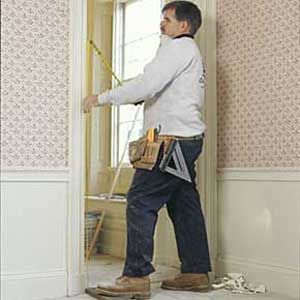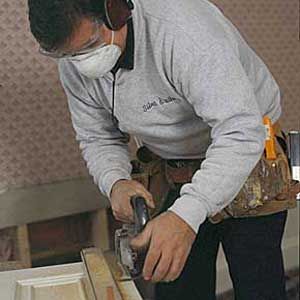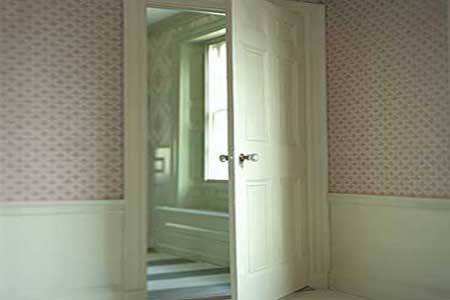Salvaged wood doors can add character and charm to your home, but fitting them into new frames can require some adjustments. Like tailoring a secondhand suit, you may need to make some alterations to achieve the perfect fit. In this guide, we’ll walk you through the process of fitting old doors in new frames, from assessing your door and frame to making adjustments and adding finishing touches. We’ll cover techniques that preserve the door’s beauty while prioritizing functionality.
The Challenge of Old Doors in New Frames
Fitting old doors into new frames presents unique challenges due to variations in size, style, and construction. Modern door frames may have different dimensions or hardware placements than those for which the old door was originally designed. Older doors may have settled or warped over time, further complicating the fitting process.
The key to success lies in careful measurements, planning, and execution. By understanding the requirements of your door and frame, you can determine the best approach for a proper fit. This may involve trimming the door, adding filler strips, or repositioning hardware to align with existing strike plates.

Assessing Your Door and Frame
Before beginning any modifications, assess your old door and the new frame. This evaluation will guide your approach and help you determine the extent of adjustments needed.
Measuring the Door and Opening
Start by measuring the height and width of both the door and the frame opening. Take measurements at multiple points, as old doors and frames may not be perfectly square. Note any discrepancies in size between the door and the opening, keeping in mind that you’ll need to leave gaps for the door to swing open and closed.
Identifying Door Type and Material
Determine the type of door you’re working with: solid wood, hollow core, or another material. Solid wood doors offer more flexibility for modifications but may require different techniques than hollow core doors. Also, consider the door’s finish. Painted doors are generally easier to alter without visible signs of modification compared to those with clear finishes.
Preparing for the Door Fitting Process
You need the right tools and safety equipment to tackle a door refitting project. Here’s what you’ll need:
- Circular saw with a sharp blade
- Measuring tape
- Pencil
- Sandpaper and sanding block
- Sawhorses
- Screws and drill
- Shims
- Straightedge and clamps
- Wood glue
For more complex modifications, you may also need a belt sander, random-orbit sander, and additional carpentry tools.
Safety Precautions
When working with power tools and wood, safety should be your top priority. Always wear safety glasses, ear protection, and a dust mask. Ensure your work area is well-ventilated and free of tripping hazards. When using a circular saw, follow proper safety procedures and use a guide for straight cuts.
Adjusting Oversized Doors
If your old door is too large for the new frame, you’ll need to trim it down to size. This requires careful planning to maintain the door’s proportions and functionality.

Trimming Door Height
To reduce the height of an oversized door, follow these steps:
- Remove the door from its hinges and place it on sawhorses.
- Measure and mark the amount to be trimmed.
- Clamp a straightedge to the door as a guide for your circular saw.
- Carefully cut along the marked line, ensuring a straight and even cut.
- Sand the cut edge smooth.
Keep in mind that you need a 1/8-inch gap at the top and a 1/4-inch gap at the bottom. If significant height reduction is needed, consider trimming from both the top and bottom to maintain the door’s proportions.
Reducing Door Width
For doors that are too wide, do the following:
- If only a small amount needs to be removed, trim only from the hinge side to avoid repositioning the latch.
- For larger reductions, trim evenly from both sides to maintain balance.
- Use the same cutting and sanding process as for height reduction.
- If trimming the latch side, you’ll need to reposition the latch hardware.
Remember to leave a 1/8-inch gap on each side of the door for proper operation.
Adapting Undersized Doors
When dealing with doors that are too small for the new frame, you’ll need to add material to increase their dimensions. This process requires more skill and attention to detail to achieve a seamless look.
Adding Filler Strips to Door Height
To increase the height of an undersized door, follow these steps:
- Cut off a small portion of the rail you want to extend to expose fresh wood for better glue adhesion.
- Measure the gap between the door and the frame at multiple points.
- Cut a filler strip slightly wider than the largest measured gap and 1/4 inch longer than the door’s width.
- Glue the filler strip to the door using polyurethane or wood glue.
- Clamp the filler in place, ensuring it sits 1/8 inch from the door’s face.
- Once dry, sand the filler flush with the door’s surface.
The joint where the rail and stile intersect is evident on most wood doors, To disguise your repair, extend the joint line across the filler piece by scoring it with a utility knife. Use a square to guide the knife.
Expanding Door Width
To increase a door’s width, follow the same process as for height expansion but attach filler strips to the stiles instead. If you’re adding width to the latch side, you’ll need to reposition the latch hardware. Sand the fillers flush with the door’s surface and finish to match the existing door.
Techniques for a Perfect Door Fit
Achieving a perfect fit involves more than just matching dimensions. You’ll need to consider hardware alignment and proper gaps for smooth operation.
When fitting an old door in a new frame, try to align the door’s latch hardware with existing strike plates, if possible. This approach often yields the best results and minimizes additional modifications to the frame. If you need to reposition hardware, carefully fill old holes with wood filler or plugs, and refinish to match the door’s surface before drilling new holes.
Professional vs. DIY Door Fitting
While many door-fitting tasks can be accomplished by experienced DIYers, some situations call for professional expertise. Consider hiring a professional if you encounter any of the following:
- Extensive modifications
- Lack of tools or experience
- Structural changes to the frame
- Valuable antique doors
Finishing Touches and Maintenance for Your Door
After fitting your old door to its new frame, you need to finish and maintain it.
Painting and Sealing
Once all modifications are complete, sand any worked areas smoothly and apply a finish that matches the rest of the door. For painted doors, prime any bare wood before applying the final coat. Clear-finished doors may require staining to match the original color before applying a protective clear coat.
Regular Upkeep for Fitted Doors
To keep your fitted door in good condition, periodically check and tighten hardware and lubricate hinges as needed. Clean the door regularly with appropriate products, and address any signs of wear or damage promptly.

